Tom Lasater, who ranched in South Texas and in Colorado in the USA, developed the Beefmaster in 1948 through strategic cross-breeding of Brahman, Hereford and Shorthorn.
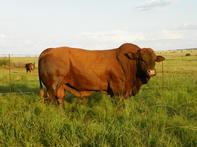
According to The Dale Lasater Ranch, Tom did not plan on developing a new breed, but aimed to produce profitable functional cattle, with the ability to thrive with minimal inputs, under harsh production conditions.
The Foundation Beefmaster herd has been closed since 1937, which means that no new genetic material, such as cows, bulls, semen or embryos had been introduced into the herd since then. The general expectation was that this would lead to inbreeding problems, after some time, but instead, it resulted in a superior breed that produces uniform high-quality offspring and beef.
Interestingly, Dr Jan Bonsma, the Bonsmara pioneer in South Africa, was friends with Tom Lasater, so the Bonsmara and Beefmaster developed relatively simultaneously, with various similarities, according to Beefmaster South Africa. For one, both breeds comprise 25% Hereford and 25% Shorthorn, but the Bonsmara has 50% Afrikaner, whereas the Beefmaster has 50% Brahman.
The Beefmaster received its name because it was seen as superior, or the “master of all beef breeds.” It was accepted as a new breed by the United States Department of Agriculture in 1954.
Production in South Africa
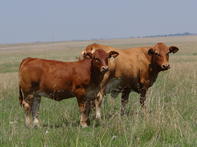
Beefmaster cattle are a large breed of cattle known for its beef production in South Africa. According to Beefmaster SA, Tony Brink is seen as the pioneer of the breed in the country. In 1970, he imported the first Beefmaster semen via Botswana to his farm Nietverdiend in north-west Transvaal, now called North West Province.
The male offspring were only classified as phase 1 animals, but still made a huge contribution to herds in the country, since there was a shortage of good quality bulls at the time.
When it became illegal to import genetic material, quite a few familiar cattle farmers also “smuggled” semen into the country. The demand for the genetic material grew strongly, resulting in the first Beefmaster club being hosted in November 1985 on Pieter Bosch’s farm, Mansole, near Bela Bela in Limpopo.
Pieter Bosch and Tony Brink hosted the first auction shortly thereafter and the Beefmaster Cattle Breeders Society of South Africa was established in 1986 with Pieter Bosch as the first President. The breed was accepted by SA Studbook in 1987, after which genetic material could be imported legally from the United States.
Attributes
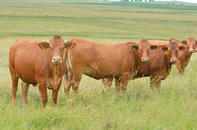
The Beefmaster is a medium framed breed, with cows ready to produce their first calves from the age of 14 months and an average inter calf period of 397 days. The cows make excellent mothers, with above average milk. Calves are small at birth, resulting in birth complications being almost non-existent, but grow fast and in effect achieve some of the best weaning weights of all the breeds.
Beefmaster SA, as far as possible, aims to use scientific tools to improve the breed. All stud animals, in effect, have to be approved through the Studbook evaluation system before they can be used as stud animals.
Registered animals have to comply with high standards, with bulls being marked with a “B” on the right flank to show it complies with these standards. The Beefmaster, at the time of writing, was one of the fastest growing and second largest breeds with SA Studbook.
The colour of the Beefmaster has never really been a breeding priority, but the cattle generally have red coats.
Production Regions
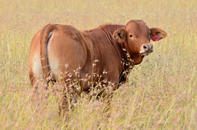
Beefmaster cattle have a great temperament, making them easy to manage. They are also highly adaptable, so are produced throughout South Africa, from the Sneeuberge in the Eastern Cape to the Sandveld of the Kalahari.
Use
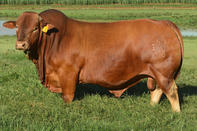
Beefmaster cattle can be used on their own in closed herds, or in crossbreeding programmes to produce hybrid vigour and enhance meat quality, maternal traits and hardiness of other breeds.
Registered Beefmaster bulls, for example, are able to easily increase the weaning weight of commercial herds by twenty to thirty kilograms, resulting in farmers making more per calf than they would have with some of the indigenous breeds.
Feedlots are willing to pay a premium for Beefmaster calves, because of their adaptability, the fast rate at which the calves gain weight and the high percentage meat produced by the cattle.
Meat Quality
The quality of Beefmaster beef is excellent, resulting in high consumer and abattoir demand.
For bulk or Beefmaster Beef export enquiries please use the enquiry link below.